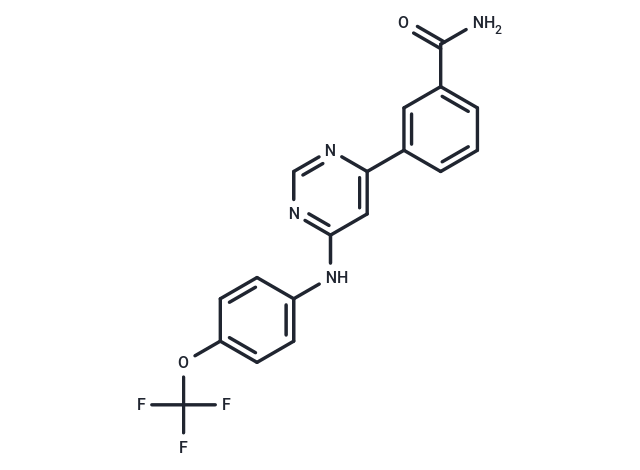Shopping Cart
- Remove All
 Your shopping cart is currently empty
Your shopping cart is currently empty

GNF-2 is a highly selective non-ATP competitive inhibitor of Bcr-Abl.

| Pack Size | Price | Availability | Quantity |
|---|---|---|---|
| 5 mg | $37 | In Stock | |
| 10 mg | $59 | In Stock | |
| 25 mg | $122 | In Stock | |
| 50 mg | $221 | In Stock | |
| 100 mg | $329 | In Stock | |
| 200 mg | $475 | In Stock | |
| 1 mL x 10 mM (in DMSO) | $39 | In Stock |
| Description | GNF-2 is a highly selective non-ATP competitive inhibitor of Bcr-Abl. |
| Targets&IC50 | BCR-ABL (SUP-B15 cell lines):268 nM, BCR-ABL (K562 cell lines):273 nM |
| In vivo | GNF-2, at a concentration of 1 μM, induces apoptosis in Ba/F3.p210 and Ba/F3.p210E255V cells and significantly reduces phosphorylated Stat5 levels in Ba/F3.p210 cells. It inhibits Bcr-abl tyrosine phosphorylation in a dose-dependent manner, with an IC50 value of 267 nM. Furthermore, 10 μM GNF-2 inhibits BCR-Abl-dependent cell proliferation, requiring the BCR and/or c-Abl SH3 and/or SH2 domains, and significantly suppresses CrkII tyrosine phosphorylation in a dose-dependent manner. GNF-2 demonstrates an inhibition effect on CrkII phosphorylation in cells expressing c-AblG2A, with an IC50 of 0.051 μM, and inhibits autophosphorylation and proliferation in cells expressing p210Bcr-Abl and its mutants, BafF3. When combined with GNF-5 (20 nM), GNF-2 (8 nM) shows a synergistic effect in inhibiting Abl64-515 kinase activity. It also exhibits dose-dependent inhibitory effects on the growth of Bcr-abl positive cells (IC50 values: 273 nM for K562 and 268 nM for SUP-B15) and Ba/F3.p210E255V and Ba/F3.p185Y253H cells, with IC50 values of 268 nM and 194 nM, respectively. |
| Kinase Assay | Binding assay: Recombinant proteins (100 nM for each construct) or immunoprecipitated proteins are diluted in kinase buffer (20 mM HEPES (pH 7.4), 50 mM KCl, 0.1% CHAPS, 30 mM MgCl2, 2 mM MnCl2, 1 mM DTT, and 1% glycerol). Aliquots of the diluted proteins are preincubated with either DMSO or compounds for 30 min at room temperature and then added to K-LISA PTK EAY reaction plates. The kinase reaction is initiated by adding 0.1 mM ATP and is allowed to proceed for 30 min at room temperature. The phosphorylation of GST-Abltide is monitored by SDS-PAGE and phosphorimaging analysis or autoradiography. |
| Cell Research | Cells (0.3-0.6 × 106 per mL) are plated in duplicate or triplicate in 96-well plates containing increasing GNF-2 concentrations (5 nM–10 μM). After incubation at 37 ℃ in 5% CO2 for 48 hours, the effect of GNF-2 on cell viability is determined by the MTT colorimetric dye reduction method. Inhibition of cell proliferation is calculated as a percentage of growth of DMSO-treated cells, and IC50 values are determined with Microsoft Excel XLfit3.(Only for Reference) |
| Alias | GNF2 |
| Molecular Weight | 374.32 |
| Formula | C18H13F3N4O2 |
| Cas No. | 778270-11-4 |
| Smiles | NC(=O)c1cccc(c1)-c1cc(Nc2ccc(OC(F)(F)F)cc2)ncn1 |
| Relative Density. | 1.405g/cm3 |
| Storage | Powder: -20°C for 3 years | In solvent: -80°C for 1 year | Shipping with blue ice. | |||||||||||||||||||||||||||||||||||
| Solubility Information | DMSO: 37.4 mg/mL (99.91 mM), Sonication is recommended. Ethanol: 18.7 mg/mL (49.96 mM), Sonication is recommended. | |||||||||||||||||||||||||||||||||||
Solution Preparation Table | ||||||||||||||||||||||||||||||||||||
Ethanol/DMSO
DMSO
| ||||||||||||||||||||||||||||||||||||

Copyright © 2015-2025 TargetMol Chemicals Inc. All Rights Reserved.